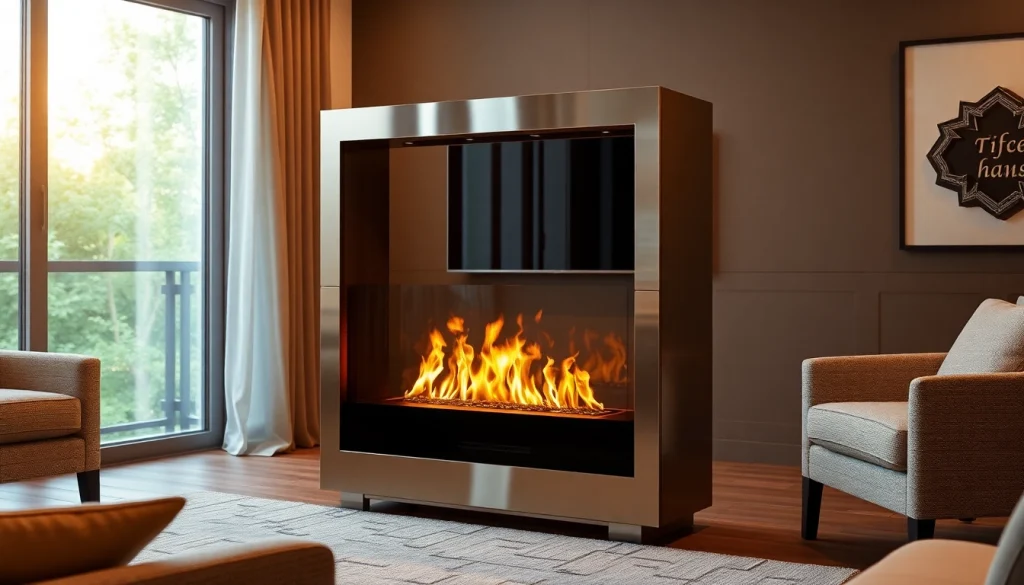
What is an Automatic Bioethanol Fireplace?
Definition and Functionality
An automatic bioethanol fireplace is a modern heating solution that combines aesthetics with advanced technology to offer convenience and warmth. Unlike traditional wood-burning or gas fireplaces, an automatic bioethanol fireplace primarily uses bioethanol fuel, a renewable and clean-burning source derived from plant materials. This fireplace type features automated functionality, allowing users to operate it easily via remote control or smart home systems, making it an attractive choice for contemporary homes.
How It Works: Technology Behind the Flames
The technology behind automatic bioethanol fireplaces is quite sophisticated yet designed for user-friendliness. At the heart of its operation is an electronic ignition system that ensures a quick start-up. When activated, the fireplace ignites bioethanol fuel stored in a built-in reservoir. The fuel is fed into a burner via an automated pump system. The flame height can often be adjusted remotely, allowing for personalized ambiance settings. Additionally, many models are equipped with safety features such as temperature sensors and oxygen depletion sensors, automatically shutting down the fireplace when certain safety thresholds are reached.
Energy Efficiency and Eco-Friendliness
One significant advantage of an automatic bioethanol fireplace is its energy efficiency. Bioethanol burns cleanly, producing only water vapor and carbon dioxide, which means it provides a sustainable option for heating without contributing to air pollution. In comparison to traditional fuels, bioethanol has a higher energy output per unit volume, making it an efficient heating solution. Furthermore, because it does not require a chimney or flue, no heat loss occurs through ventilation, ensuring that most of the heat generated remains within the living space.
Benefits of Installing an Automatic Bioethanol Fireplace
Convenience and Ease of Use
The convenience of an automatic bioethanol fireplace is unparalleled. Users can start, stop, and adjust the flames from the comfort of their seating area through a remote control or a smartphone app. This ease of use eliminates the mess commonly associated with wood-burning fireplaces, such as ash and soot. Additionally, refueling the fireplace is straightforward; simply refill the bioethanol reservoir, and no further maintenance is typically required beyond routine cleaning.
Design Versatility for Any Space
Automatic bioethanol fireplaces come in various designs and sizes, making them suitable for any space, whether it be a cozy apartment or a spacious home. They can be installed as wall-mounted units, free-standing models, or even embedded into furniture. Many come with sleek, modern finishes that complement contemporary decor, while others may exhibit a more classic design, appealing to traditional aesthetics. This versatility allows homeowners to incorporate a fireplace into their interior design seamlessly.
Creating a Cozy Ambiance in Your Home
Nothing quite compares to the ambiance provided by a real flame. An automatic bioethanol fireplace creates a warm and inviting atmosphere, perfect for entertaining guests or enjoying a quiet evening at home. With adjustable flame heights and designs that allow for dramatic visual impact, these fireplaces often become a focal point in a room, enhancing not only the space’s warmth but also its overall aesthetic appeal.
Comparing Automatic to Traditional Fireplaces
Fuel Types: Bioethanol vs. Wood and Gas
When comparing fuel types, bioethanol stands out due to its renewable origin and clean-burning properties. Traditional wood-burning fireplaces generate smoke, soot, and ash, requiring extensive cleaning and maintenance. Gas fireplaces, while cleaner than wood, need a gas line installation and can produce harmful emissions. Automatic bioethanol fireplaces, in contrast, require only bioethanol fuel, which doesn’t emit harmful pollutants, allows for easy refueling, and doesn’t require a chimney, all while delivering the same warmth and aesthetic pleasure as traditional options.
Installation Requirements and Costs
Installation of an automatic bioethanol fireplace is generally more straightforward compared to traditional fireplaces. Since they do not require venting or flues, installations can often be completed without extensive remodeling. This ease of installation can result in cost savings, allowing homeowners to invest that saved money in higher-quality designs or features. However, initial costs for automatic bioethanol fireplaces can vary significantly, depending on design, brand, and features, typically ranging from affordable models to luxury versions outfitted with premium functionalities.
Safety Features: What to Look For
Safety is a paramount concern when it comes to any heating appliance, and automatic bioethanol fireplaces often come equipped with essential safety features. When evaluating models, look for safety sensors, such as flame failure sensors that automatically cut off fuel supply when the flame is extinguished. Oxygen depletion sensors are another crucial feature, shutting down the fireplace if oxygen levels drop too low for safe operation. Additionally, choosing a model with a tempered glass front can protect users from accidental burns and enhance the unit’s safety profile.
Choosing the Right Automatic Bioethanol Fireplace
Key Features to Consider
Selecting the right fireplace requires careful consideration of key features. Features to prioritize include adjustable flame height, easy-to-use remote controls or smart home compatibility, fuel efficiency, and safety mechanisms. Furthermore, assess the size of the unit in relation to the intended installation space; a fireplace that fits well in your home’s design without overwhelming the room is ideal. Additionally, consider additional aesthetic aspects such as the overall design and finish to ensure it blends seamlessly with your existing decor.
Assessing Your Space and Aesthetic Needs
Every home is unique, and the right fireplace will reflect both the functional needs and aesthetic preferences of its owner. Before deciding on a model, evaluate the available space, including dimensions and layout. Smaller rooms may benefit from wall-mounted fireplaces or compact free-standing units, while larger areas can accommodate more significant designs that make a bold statement. Use visual design tools or apps to visualize how different models would look in your space prior to purchasing.
Top Brands and Models in the Market
The market for automatic bioethanol fireplaces is rich with options, with several reputable brands leading the way. Well-established names include Ignis Products, which offers a variety of models focused on innovation and safety. AFIRE is another brand noted for its elegance and advanced safety features, while Planika stands out with its modern technological integration and stylish designs. Exploring user reviews can provide insight into performance and customer satisfaction, guiding potential buyers towards the most reliable options.
Maintenance Tips for Optimal Performance
Regular Cleaning Procedures
Maintaining an automatic bioethanol fireplace is relatively simple compared to maintaining traditional models. Regular cleaning is essential to keep the glass clear and the unit functioning well. Use a glass cleaner specifically designed for high-heat applications or a mixture of water and vinegar. Wipe down surfaces with a soft cloth to avoid scratching. Avoid abrasive materials which could damage the fireplace’s finish.
Fuel Management for Longevity
Proper management of bioethanol fuel is vital for ensuring optimal performance and longevity of the fireplace. It’s crucial to use high-quality bioethanol specifically designed for these units. Storing fuel in a cool, dry place is essential, as excessive heat can lead to expansion and spillage. Additionally, regularly check fuel levels and maintain the cleanliness of the fuel reservoir to prevent build-up that could lead to performance issues.
Safety Protocols for Usage
Ensuring safety during operation is paramount. Always follow the manufacturer’s instructions for fuel use and fireplace operation. Never attempt to refill the bioethanol reservoir while the unit is in operation or still warm. Additionally, keep flammable materials away from the fireplace and regularly inspect safety features to ensure they are functioning correctly. Establishing a routine for safety checks can prevent accidents and enhance the fireplace’s longevity.






